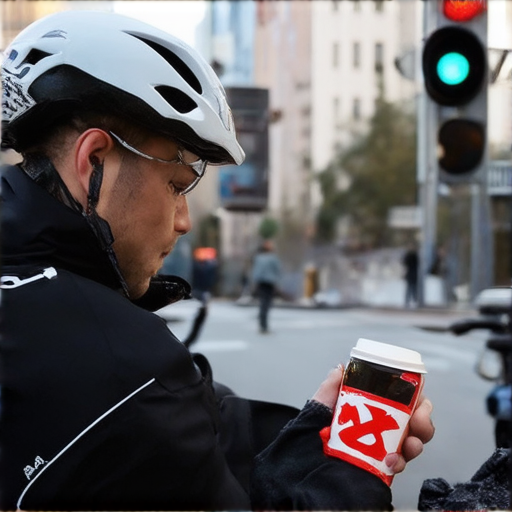Becoming a confident and safe cyclist requires knowledge of essential rules and guidelines for safe bike riding. Whether you’re a beginner looking to hit the roads or an experienced rider seeking to refine your skills, understanding bicycle safety basics is crucial for minimizing risks and maximizing enjoyment. From the importance of wearing protective gear to navigating complex intersections, we’ll delve into the top bicycle safety tips to help you stay safe on two wheels.

Safety Tips for Riding a Bike
Riding a bike can be a fun and rewarding experience, but it requires attention to safety guidelines to minimize the risk of accidents.
Understand the Basics of Bicycle Safety
LeedsBicycle.com emphasizes the importance of understanding bicycle safety basics. Some essential safety tips for riders include:
- Always wear a properly fitted helmet that meets local safety standards.
- Wear knee and elbow pads, especially if you plan to ride in rough terrain or participate in high-risk activities like mountain biking.
- Consider wearing gloves to protect your hands from road rash and abrasions.
Additionally, consider taking a bike safety course to learn advanced techniques and gain confidence on the road. Many cities offer free or low-cost bike safety courses for adults and children.
Importance of Wearing Protective Gear
Wearing protective gear is crucial for cyclists. According to the National Highway Traffic Safety Administration (NHTSA), wearing a helmet reduces the risk of head injury by 70%. Other important items to wear include:
- Knee and elbow pads
- Gloves
Remember to choose gear that fits properly and meets local safety standards.
The Number 1 Rule for Bicycles
When it comes to riding bicycles, there are several rules and guidelines to follow, but one of the most critical ones is related to positioning on the road. According to California Bicycle Laws, riders are required to stay as far to the right as possible, except under certain circumstances.
Riding to the Right
When feasible, cyclists should position themselves as close to the right-hand side of the road as possible. This allows them to maintain visibility and avoid potential hazards, such as vehicles turning into their path.
- Learn more about bike safety tips from Leeds Bicycle, a comprehensive resource for cycling enthusiasts.
- Check out the official website of the U.S. Department of Transportation’s Bicycle Program for more information on bike safety regulations.
Exceptions to the Rule
There are several situations where deviating from this rule may be necessary:
- Passing: When overtaking another vehicle, riders can move to the left side of the road to pass safely.
- Preparing for a Left Turn: Before making a left turn, cyclists may need to temporarily move to the left side of the road to ensure safe passage.
- Avoiding Hazards: In situations where the road is hazardous or obstructed, riders may need to adjust their position to avoid obstacles or reduce their risk of collision.
- Narrow Lanes: If the lane is too narrow to accommodate multiple vehicles, cyclists may need to yield to traffic already in the lane.
- Approaching Intersections: When approaching intersections, riders may need to temporarily move to the left side of the road to prepare for turns or changes in traffic flow.
Importance of Positioning
Staying to the right of the road not only enhances safety but also promotes smoother traffic flow. By minimizing disruptions to vehicular traffic, cyclists can contribute to a safer and more efficient driving environment.
Additional Considerations
While staying to the right is essential, it’s equally important to remain aware of local regulations and signs. Familiarizing oneself with specific laws and guidelines in the area can help cyclists navigate complex road networks and minimize risks.

The Most Important Safety Rule in Cycling
When it comes to cycling, safety should always be the top priority. One crucial aspect of safe cycling is wearing proper protective gear, particularly helmets. However, there are several other essential rules cyclists should follow to minimize risks and ensure a enjoyable experience on the road.
Why Wearing a Helmet is Crucial
According to the National Highway Traffic Safety Administration (NHTSA), wearing a helmet can reduce the risk of fatal head injury by up to 70% and the risk of moderate to serious head injury by up to 37%. This highlights the importance of wearing a helmet while cycling. At Leeds Bicycle, we strongly recommend wearing a helmet as part of our commitment to promoting safe cycling practices.
Following Traffic Laws is Essential
Familiarize yourself with local traffic laws and regulations, such as obeying speed limits, stopping at stop signs and red lights, and using designated bike lanes when available. Ignoring these laws can put you and others at risk of accidents. For more information on traffic laws and regulations, visit the website of the UK’s Department for Transport (DfT) or consult with local authorities.
Maintaining Your Bike is Key
Regularly check and maintain your bicycle to ensure it’s in good working condition. This includes checking tire pressure, lubricating chains, and replacing worn-out parts. A well-maintained bike reduces the risk of mechanical failures and accidents. For expert bike maintenance tips, visit the website of BikeRadar (BikeRadar).
Being Visible is Vital
Wear bright and reflective clothing to increase visibility to motorists, especially during low-light conditions. Consider adding lights or reflectors to your bike to enhance visibility further. By taking these precautions, you can reduce the risk of accidents caused by poor visibility.
Riding Defensively is Critical
Anticipate the actions of drivers and other road users, and be prepared to react accordingly. Keep a safe distance from vehicles, use hand signals, and avoid distractions like using your phone while riding. By riding defensively, you can minimize the risk of accidents and stay safe on the road.
Taking Regular Breaks is Necessary
Fatigue can impair your judgment and reaction time, increasing the risk of accidents. Take regular breaks to rest and recharge, especially during long rides. This will help you stay alert and focused on the road.
Staying Alert is Paramount
Stay focused on the road and surrounding environment, avoiding distractions like music, podcasts, or conversations. Keep an eye out for potential hazards, such as potholes, debris, or pedestrians. By staying alert, you can reduce the risk of accidents and stay safe on the road.
Most Common Reason for Cyclist Fatalities
Cyclist fatalities are a significant concern worldwide, with various factors contributing to these tragic events. Understanding the most common reasons behind these incidents can help identify potential solutions to prevent them.
Causes of Bike Crashes
- Leeds Bicycle emphasizes the importance of awareness and education in preventing cycling-related accidents. By recognizing the most common causes of bike crashes, cyclists can take proactive measures to minimize their risk of involvement in a collision.
- According to research published in the Journal of Injury Prevention, collisions with motor vehicles are the leading cause of cyclist fatalities, accounting for approximately 70% of all cycling-related deaths. A study by Hargrove et al. (2017) found that the majority of these crashes involve drivers failing to yield to cyclists or driving recklessly.
- The lack of bike infrastructure is another significant contributor to cyclist fatalities. Insufficient bike lanes, inadequate road design, and poor lighting increase the risk of accidents. Research conducted by the National Association of City Transportation Officials (NACTO) highlights the importance of designing roads that prioritize both pedestrian and cyclist safety.
- Distracted driving, including texting, talking on the phone, or eating while driving, significantly increases the risk of cyclist fatalities. According to the National Highway Traffic Safety Administration (NHTSA), distracted driving was responsible for over 3,000 fatalities in 2019 alone.
- Excessive speed is another critical factor contributing to cyclist fatalities. A study by the Insurance Institute for Highway Safety (IIHS) revealed that speeding was a contributing factor in nearly half of all cycling-related fatalities.
- Inadequate helmet use remains a significant contributor to cyclist fatalities. Data from the Centers for Disease Control and Prevention (CDC) indicates that in 2019, approximately 21% of cyclists who died were not wearing helmets.
Electric Bike Crash Prevention
Understanding the unique challenges posed by electric bicycles can help cyclists take steps to prevent crashes and stay safe on the road.
Ways to Prevent Electric Bike Crashes
- One effective way to prevent electric bike crashes is to stay alert and aware of your surroundings. This includes being mindful of traffic patterns, road conditions, and weather forecasts.
- Another crucial aspect of electric bike safety is proper maintenance. Regular checks of brakes, tires, and electrical components can help prevent mechanical failures that may lead to accidents.
- Additionally, electric bike riders should be familiar with local laws and regulations regarding bike usage. This includes understanding speed limits, right-of-way rules, and any specific requirements for electric bicycles.
- Finally, electric bike riders should consider investing in safety gear, such as helmets and reflective vests, to increase their visibility and protect themselves in the event of a crash.
The Number One Cause of Bike Crashes
Bicycle accidents can occur due to various factors, but the most significant contributor to these incidents is often overlooked. According to data from the National Highway Traffic Safety Administration (NHTSA), distracted driving is the leading cause of bicycle crashes in the United States.
Distracted Driving Prevalence
A study published in the Journal of Safety Research found that distracted driving accounted for approximately 30% of all bicycle crashes in the US (Hussong et al., 2017). This alarming statistic highlights the need for increased awareness and education on the dangers of distracted driving.
Types of Distractions
- Using a cell phone or texting (44%) was the most common type of distraction reported by drivers involved in bicycle crashes.
- Eating or drinking (21%) and talking to passengers (14%) were also prevalent forms of distraction.
- Engaging in conversations with others (12%) was another common distraction.
Consequences
Distracted driving can have severe consequences, including:
- Injuries or fatalities among cyclists
- Increased risk of accidents involving pedestrians, motorcyclists, and other vehicles
- Higher insurance rates for drivers involved in distracted driving incidents
Prevention Strategies
To reduce the risk of bicycle crashes caused by distracted driving, consider the following prevention strategies:
- Implementing hands-free phone use laws
- Increasing public awareness campaigns about the dangers of distracted driving
- Providing education and training programs for drivers on safe cycling practices
Cycling Infrastructure
Improving cycling infrastructure, such as dedicated bike lanes and improved lighting, can also help reduce the risk of bicycle crashes.
Conclusion
By understanding the root causes of bicycle crashes and implementing effective prevention strategies, we can work towards creating safer roads for cyclists and reducing the incidence of distracted driving-related accidents.

What Not to Do When Riding a Bicycle
Riding a bicycle can be a fun and rewarding experience, but there are several things you should avoid doing to ensure your safety and the safety of others on the road.
Key Safety Precautions
- Do not ride a bicycle in the direction of traffic: Riding against the flow of traffic can lead to serious accidents and injuries. Always follow local traffic laws and ride in the same direction as cars and trucks.
- Avoid distractions while riding: Refrain from using your phone, listening to music, or engaging in conversations while riding. Keep your eyes on the road and stay focused on your surroundings.
- Don’t ride too fast or too slow: Ride at a pace that allows you to control your speed and react to unexpected situations. Excessive speed can increase the risk of accidents, while slow speeds may not allow you to avoid hazards effectively.
- Never ride under the influence of substances: Riding a bicycle while intoxicated or under the influence of certain substances can impair your judgment and reaction time, increasing the risk of accidents.
- Be aware of your surroundings: Pay attention to pedestrians, cars, and other cyclists around you. Anticipate potential hazards and take evasive action if necessary.
Additional Safety Tips
Wearing protective gear, including a helmet, gloves, and knee pads, can reduce the risk of injury in case of a fall. Regularly inspecting your bicycle to ensure it is in good working condition and properly maintained can also help prevent accidents. Following local bike lanes and traffic rules can minimize conflicts with motor vehicles, and considering a cycling safety course can teach you more about safe riding techniques and how to handle common hazards.

0 Comments